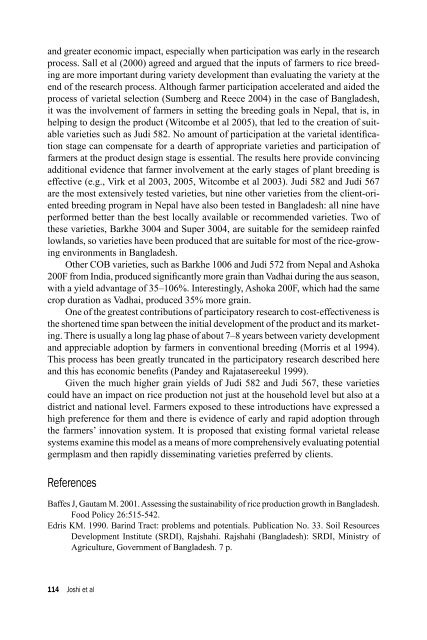Download (2461kB) - University of Greenwich
Download (2461kB) - University of Greenwich
Download (2461kB) - University of Greenwich
- No tags were found...
Create successful ePaper yourself
Turn your PDF publications into a flip-book with our unique Google optimized e-Paper software.
and greater economic impact, especially when participation was early in the researchprocess. Sall et al (2000) agreed and argued that the inputs <strong>of</strong> farmers to rice breedingare more important during variety development than evaluating the variety at theend <strong>of</strong> the research process. Although farmer participation accelerated and aided theprocess <strong>of</strong> varietal selection (Sumberg and Reece 2004) in the case <strong>of</strong> Bangladesh,it was the involvement <strong>of</strong> farmers in setting the breeding goals in Nepal, that is, inhelping to design the product (Witcombe et al 2005), that led to the creation <strong>of</strong> suitablevarieties such as Judi 582. No amount <strong>of</strong> participation at the varietal identificationstage can compensate for a dearth <strong>of</strong> appropriate varieties and participation <strong>of</strong>farmers at the product design stage is essential. The results here provide convincingadditional evidence that farmer involvement at the early stages <strong>of</strong> plant breeding iseffective (e.g., Virk et al 2003, 2005, Witcombe et al 2003). Judi 582 and Judi 567are the most extensively tested varieties, but nine other varieties from the client-orientedbreeding program in Nepal have also been tested in Bangladesh: all nine haveperformed better than the best locally available or recommended varieties. Two <strong>of</strong>these varieties, Barkhe 3004 and Super 3004, are suitable for the semideep rainfedlowlands, so varieties have been produced that are suitable for most <strong>of</strong> the rice-growingenvironments in Bangladesh.Other COB varieties, such as Barkhe 1006 and Judi 572 from Nepal and Ashoka200F from India, produced significantly more grain than Vadhai during the aus season,with a yield advantage <strong>of</strong> 35–106%. Interestingly, Ashoka 200F, which had the samecrop duration as Vadhai, produced 35% more grain.One <strong>of</strong> the greatest contributions <strong>of</strong> participatory research to cost-effectiveness isthe shortened time span between the initial development <strong>of</strong> the product and its marketing.There is usually a long lag phase <strong>of</strong> about 7–8 years between variety developmentand appreciable adoption by farmers in conventional breeding (Morris et al 1994).This process has been greatly truncated in the participatory research described hereand this has economic benefits (Pandey and Rajatasereekul 1999).Given the much higher grain yields <strong>of</strong> Judi 582 and Judi 567, these varietiescould have an impact on rice production not just at the household level but also at adistrict and national level. Farmers exposed to these introductions have expressed ahigh preference for them and there is evidence <strong>of</strong> early and rapid adoption throughthe farmers’ innovation system. It is proposed that existing formal varietal releasesystems examine this model as a means <strong>of</strong> more comprehensively evaluating potentialgermplasm and then rapidly disseminating varieties preferred by clients.ReferencesBaffes J, Gautam M. 2001. Assessing the sustainability <strong>of</strong> rice production growth in Bangladesh.Food Policy 26:515-542.Edris KM. 1990. Barind Tract: problems and potentials. Publication No. 33. Soil ResourcesDevelopment Institute (SRDI), Rajshahi. Rajshahi (Bangladesh): SRDI, Ministry <strong>of</strong>Agriculture, Government <strong>of</strong> Bangladesh. 7 p.114 Joshi et al
















